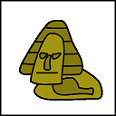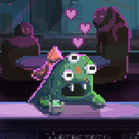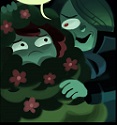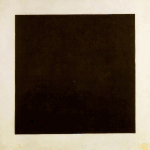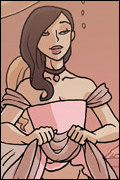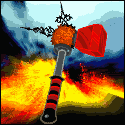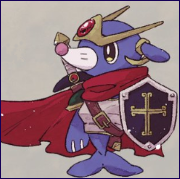|
Hey, question for people more knowledgeable about board games than myself- has anyone ever made a cooking themed card game besides A la Carte? I have a game prototype that I made at home, and I love playing it but before I invest any more time developing it I want to make sure I'm not inadvertently ripping off anyone's existing concept. Specifically, mine is themed on an Iron Chef-like cooking tournament and it's intended to have kind of an over-the-top funny tone. So maybe it's still original if there's a super duper serious cooking battle game out there...
|
|
|
|

|
| # ? May 15, 2024 21:42 |
|
There's lots of cooking themed games - even an official Iron Chef board game (which I assume is terrible). I've heard people say Wok Star is really good, I think people like Sushi Go. Scoville, a recent release, is about growing and making recipes out of peppers (I think?). There's lots of board games about everything. Anyway, I wouldn't worry about it. If your game works well, it needn't matter much if there's games out there with similar themes.
|
|
|
|
Pressure Cooker, I have it coming in the mail. 
|
|
|
|
OK a quick search of those titles tell me that I'm not infringing on their mechanics, even though we're in similar territory thematically. So yeah, I think I'll forge ahead- I'll be back when I have a little more coherent version of the prorotype. Right now it's at that stage where I'm still chuckling at my own jokes but I need to make sure it can hold up to actual play with people who aren't me or my s/o.
|
|
|
|
I'm kind of a dabbler into the board game design setting. There was a brief game I was working on where I actually made some mini-prototypes (it was a game about amoebas in a crowded Petri dish), but other than that, I usually just come up with kooky ideas. So here are a couple ideas (really, not much more than mechanics) that I've come up with. The first one was having actions which require other players to activate them. This was for a game I called "Clumsy Robots." You play as a group of robots working in a shipping warehouse who are trying to be the best workers to become Employee of the Month. (Nobody's told them they don't actually qualify, since... robots.  ) The reason why they're clumsy, though, is because their programming is a little... weird. Each card has two sections, one of which is a smaller effect, while the other is a much better one. You get the small effect by playing the card on your turn, but the bigger effect requires you to place the card face-down in front of you. The bigger effect has a symbol next to it, and when an opponent plays a card matching that symbol, your card can activate. So there's this question of balancing priorities: do I take the small effect for what it is, or do I try for the big effect, even if there's the possibility that my opponents will activate it too late for me to use it, if at all? Your opponents, meanwhile, would have some indication of which symbols are most likely to be on your hidden card, giving them a dilemma, too: Do I play the card I need, knowing it might activate my opponent's hidden card, or do I hold onto it and possibly hold myself back? That's the basic idea behind the game. I was trying to figure out what the game would actually involve, but I'm actually kind of at a loss. ) The reason why they're clumsy, though, is because their programming is a little... weird. Each card has two sections, one of which is a smaller effect, while the other is a much better one. You get the small effect by playing the card on your turn, but the bigger effect requires you to place the card face-down in front of you. The bigger effect has a symbol next to it, and when an opponent plays a card matching that symbol, your card can activate. So there's this question of balancing priorities: do I take the small effect for what it is, or do I try for the big effect, even if there's the possibility that my opponents will activate it too late for me to use it, if at all? Your opponents, meanwhile, would have some indication of which symbols are most likely to be on your hidden card, giving them a dilemma, too: Do I play the card I need, knowing it might activate my opponent's hidden card, or do I hold onto it and possibly hold myself back? That's the basic idea behind the game. I was trying to figure out what the game would actually involve, but I'm actually kind of at a loss. The other mechanic I was working on was based on the idea of sleeper agents. I had this idea for a game where you control two "groups" simultaneously: a collection of civilians and a governmental information agency. As the civilians, you control four or five normal people who all have their own lives and agendas. However, one of them is secretly a sleeper agent tasked with some major espionage. (For example, killing the opponent's diplomat, or stealing weapon plans.) Once you've successfully set up the situation necessary for the sleeper agent to complete their task, you wake them up, have them perform their task, and get them out before the opponent captures them. As the government, your goal is to monitor your opponent's actions and figure out which goal they're trying to complete and which character is their sleeper agent. This won't be easy, as all the characters will be up to shady dealings the whole time. You have to figure out which clues are actually pointed towards the sleeper agent and which are just red herrings. You can do ethically-gray government stuff like random searches or even arrests, but without the evidence you need, you'll be severely punished for doing so. So the entire game is this cat-and-mouse deal on both sides, waiting for your opponent to overplay their hand, always trying to probe without getting in trouble. Unfortunately, I was having trouble figuring out how to balance it all and make the actual board work. I was thinking having different locations, each with a gameplay effect (like drawing cards or moving other characters around) and an effect that goes towards the final mission. (So your opponent might ask, "Did he go to the lab because he needed the extra card or because his sleeper agent needed the explosives from it?") But when I tried to actually draw up a board, it turned into this horribly mangled mish-mash of spaces that looked like a mix between Clue and Arkham Horror and would have been terrible to actually play on. Anyways, do you guys have any thoughts on these ideas?
|
|
|
|
quote:Once you've successfully set up the situation necessary for the sleeper agent to complete their task, you wake them up, have them perform their task, and get them out before the opponent captures them I think this is a strong idea - a little bit of Spy Party, little bit of "general traitor game", perhaps a strong hint of Tragedy Looper. My first concern would be managing the tug-of-war between "setting up the crime requires multiple steps", "you want to do some extra stuff to throw off the watcher", and "you don't want the game to go on forever". You also want ways of stopping the crime before it happens that require some "I figured this out", but that are also interactive and not anti-climactic. Tragedy Looper handles the first part by having multiple potential threats at once, each with a fairly short setup, and all governed by an interlocking set of plot/character rules (that are public, and serve to frame the potential deduction, and give a consistent set of knobs that both players can turn). It handles the second part by, well, not handling it. The players can't really stop all the threats before they happen. Instead, they do happen - but players then loop back in time after the crime has occurred to try to prevent it (and usually there's more than one possible "it") from happening again (obviously they tend to know more about the potential plots each cycle, and have a limited number of cycles in which to win). Anyway, I really like this kind of setting if you can figure out the mechanics to support it. Edit: maybe have more than 2 players, and have the "bad guy" player be secret? Have some sort of benefit to "getting checked" when you're not guilty, so everyone is motivated to look a bit suspicious. jmzero fucked around with this message at 00:08 on Feb 20, 2015 |
|
|
|
jmzero posted:
Each player publicly belongs to 1 of the 3 Factions struggling for control on the map, and each player on a Faction can move and use any of that Faction's Agents to do Actions. But each player also has a secret Loyalty to 1 of 5 Pillars of Society (essentially: the wealthy, politicians, military/police, laborers, and everyone else). The Pillars each have their own 10-point Support track and action cards, and function as a publicly shared set of resources that represent the power of these social groups struggling to survive or thrive through this on-going conflict between the Factions. The Pillars' Support tracks automatically go down 1 every few turns, or faster if any Pillars are already at 0. They'll go down quicker than that during play though, because Pillar Support can also be used as a resource to convert other resources (money, weapons, intel, influence, support, agents, control, etc.) or to gain action cards specific to particular Pillars. If all Pillars hit 0, however, all players lose. Each Agent on every Faction also has a secret Loyalty to one of these Pillars, on the bottom side of their token, which remains secret unless players use special actions to check or reveal it for individual agents. At the end of the game, each player gets VPs based on whether the Pillar they're Loyal to finished with the most Support, as well as how many living Agents on their Faction remain who are also Loyal to their chosen Pillar. They also get some VPs for how well their Faction is doing at the end, but can get more from the Pillar they are Loyal to. So each player wants their public Faction to do well, but is more interested in their Pillar doing best, and uses actions with their visible Agents and Pillar Support to accomplish both. But if they make it obvious which Pillar they're Loyal to, other players can work to bring it down. And everyone also wants to keep all Pillars from hitting 0, which is a constant pressure. Granted, this is all theoretical as I'm still working on the action cards and prototype, so my current rules are wholly untested. ------ EDIT: Maybe each player has a board with an individual track for each of their agents, and each agent is gradually working their way to the end of the track which represents them accomplishing their goal. Each player assigns each of their agents' goals at the start of the game by placing a goal card face-down next to each agent's track. Maybe 5 agents and 3 goal cards are red herrings and 2 goal cards are actual player goals. Then gameplay consists of players playing cards or doing other actions to advance agents with certain goals forward, and maybe set agents with other goals back. There could be another investigative element that might reveal more about an agent's goal by examining the actions they've done. Over the course of the game, maybe a player would only be able to stop 3 or 4 agents from reaching their end goal, so they have to choose wisely. When an agent reaches the end of their track, their goal is revealed and performed. If it's a red herring, play continues. If it's a player goal, the game ends. VPs go most to the player whose agent performed their goal, but other VPs are gained based on how far your agents went on their track? and whether you stopped other players' agents on their tracks? JMBosch fucked around with this message at 01:28 on Feb 20, 2015 |
|
|
|
VoteTedJameson posted:Hey, question for people more knowledgeable about board games than myself- has anyone ever made a cooking themed card game besides A la Carte?... Monster Chef and Wok Star, though I don't think either are that similar to your Iron Chef idea.
|
|
|
|
So I took the inspiration I had after someone mentioned an RTS type board game and have shaped it into possibly the weirdest thing that set of words could have led to. As such I want, hope, need someone to pick the idea apart and tell me whether any of it is worth salvaging. The basic premise is there are three locations that players are battling for control over. Two of the locations provide resources and the final one provides VP. Players assign units to the locations in secret and then there's a big reveal and a chance for a little interaction before determining who controls what. Control does nothing in and of itself, but some of the units you assign in secret have a Harvest ability that lets you gather resources/VP from the location, with more resources being gathered if you have control. Now on to how I'm accomplishing this, with, of all things, a deck builder. You start the game with 7 Harvesters and 3 Warriors in your deck, and draw a hand of 5 cards. Each player then plays cards from their hand face down onto the various locations until all players have passed. Then the cards are revealed and players can play spells from their hand to manipulate the battlefield. Then players determine who controls each location and gather resources as appropriate. After that players discard their hand and units and spells in play and draw a new hand.Then there's a buy phase. Then things start over again. Repeat until any player reaches a predetermined VP threshold. Right now units have one attribute: Power, which is used to determine Control, as the player with the most Power at a Location is in Control. Harvesters provide no Power and Warriors provide 2, with purchased units providing more power. You can also Upgrade old units when you buy new ones (for example when you buy an Armed Harvester you can trash a Harvester from your discard.) I'm playing around with some other ideas (units that you buy into your hand, but trash when you would discard them; asynchronous player powers) that I haven't seen in other deck builders but seem like they could work. Are there any huge flaws noticeable from this somewhat vague description?
|
|
|
|
quote:Each player then plays cards from their hand face down onto the various locations until all players have passed I like hidden action selection, but it seems like you might be coming in a bit heavy on the hidden? Is there any way you can work more information leaking into the card placing? Like, maybe some units come in hidden (face down), but other large units like battleships or whatever come in face up. And there's some tension between more efficient (but visible) units, and perhaps less efficient units that give you more flexibility or bluffing power. And some could potentially give a choice to shake things up - like, this is a 4 power unit if it's face up, or 3 if it was brought in face down. This also gives some good thematic design space for different kinds of player powers. I'm also interested to see how you balance out control and harvesting. It feels like you could easily end up making it so going "all harvesters" is too viable or, on the flip side, making it so the threshold of a loss on control could be really swingy and the overall game could snowball too hard. You don't want a bunch of stuff come down to whether you opened 5/2, and thus could control but couldn't harvest on your first turn, and could harvest but not control on your second. (Or something... anyway, it just feels like this is going to be hard to set up mechanically in a way that works). Mostly, though, you just want to avoid making Smash Up (which had some similar mechanical ideas, and is really terrible, though largely for unrelated reasons). VVV: "Thanks so much for that idea, if you don't mind my using it?" Of course not! I would love to think that some of the endless crap I spout here actually makes its way into a playable game. God knows it never goes anywhere in my own designs. jmzero fucked around with this message at 23:13 on Feb 20, 2015 |
|
|
|
jmzero posted:I like hidden action selection, but it seems like you might be coming in a bit heavy on the hidden? Is there any way you can work more information leaking into the card placing? Like, maybe some units come in hidden (face down), but other large units like battleships or whatever come in face up. And there's some tension between more efficient (but visible) units, and perhaps less efficient units that give you more flexibility or bluffing power. And some could potentially give a choice to shake things up - like, this is a 4 power unit if it's face up, or 3 if it was brought in face down. This also gives some good thematic design space for different kinds of player powers. Yep, I was a little worried about the Smash Up comparison but I think I can avoid the pitfalls of that, hopefully. And the control/Harvesting divide is something I'm still uncertain of. What I have right now is that the Resource Locations give you 2 resources per Harvester and 1 more if you have Control. While the VP location gives you 0 resources per Harvester if you don't have control or 1 if you have control. Of course this is all suspect to balancing, but I think that those values will make for a good starting place. Also I hadn't even considered cards that can be played face up, but I love that idea and it should totally help with the randomness that can seem to arise from solely hidden action selection as you pointed out. I think for starting units its good to have them all be bluffable but I think its a great idea for some more advanced units. Thanks so much for that idea, if you don't mind my using it? Anniversary fucked around with this message at 22:52 on Feb 20, 2015 |
|
|
|
I haven't gotten a chance to play lost in the woods with other people yet, but I got a chance to describe it to some people I play board games with, and I had to admit something that I'd already seen as a problem: the card playing is kind of unguided. I'm partly wondering if it's because I'm not very good at coming up with story stuff on the fly*, but also I think it might be because the cards just don't really lend to interesting conflict resolution. *I admit that this is weird that I'm designing this game, but I really do like the concept of the game (the world), and I do enjoy games that tell a story like The Wolf Among Us. I know the game Once Upon a Time has a interrupt system, and the cards are not just objects but different aspects, and maybe I need something broader like that. Or maybe another mechanic to mix things up like interrupts in OUaT. Anyone who has experience in designing or at least playing lots of storytelling games and have thoughts on this? I feel really stuck and not sure how to go forward. I feel like maybe play testing is the only way I can figure this out, but the game's not exactly playable (at least not enjoyably) yet. A strange catch-22. Another game I've been working on (no title, I'm just calling it Cyber Anti-Terror Squad, but that spells CATS, so that's not the name I'm keeping. Though it made me think of an 80s style cartoon show about a cat swat team, something like this :P) is based loosely on the universe of Ghost in the Shell and other cyberpunk works mixed with a bit of Rainbow 6 tactics. You play as a futuristic police team. The board is laid out as tiles representing rooms. Each missions has two phases, "stack" and "action". Each player gets a deck of cards representing their powers based on their class (I'm thinking so far assault and hacker. Maybe support and sniper as well. ) During stack the players start at the doors, and work their way inward, but for every step they take closer to a room with an enemy, they do some sort of check, and if they fail twice they go directly into the action phase, and are at a disadvantage. During the action phase they play cards and assault rooms. For every room they move between where they are and the enemy, it is a -1 to the check. That's all I have so far. I don't have anything near a testable game, I haven't really come up with cards yet, but it's a start. ... I also found my old board game concept Currier which is a game about plane deliveries in the interwar period somewhat inspired by the animes Porco Rosso and Last Exile. You have upgrades and fly around doing missions, but sadly the game doesn't have very much interaction between players, and the people I playtested it with seemed to find it boring. I do have a mechanic where you can spend "fate" to boost your own dice rolls or mess with others, but that really feels like a tacked-on solution (suggestions are of course welcome!) I mothballed it after that, but I should really pull it out and work on it again, since I really like the concept.
|
|
|
|
In Currier could there be competition in fulfilling the various contracts? Perhaps players can be competing to turn them in in time somehow. Though perhaps I'm misunderstanding the gameplay. As for CATS I'm curious how the the game would resolve itself, I'm a little wary of the mention of dicerolls, but I know that's just me.
|
|
|
|
Anniversary posted:In Currier could there be competition in fulfilling the various contracts? Perhaps players can be competing to turn them in in time somehow. Though perhaps I'm misunderstanding the gameplay. Well so far, each player has their own missions they are flying around doing. They pick up a mission at a location marked on the mission card and then go to where it says (they start on the table, so anyone who goes to that location can get that mission). I'm not sure how I'd incorporate some sort of "I can do it faster/cheaper" type mechanic to steal the mission away. There is one mechanic where you can play cards to move storms (storm and tornado), pirates (pirate raids and the pirate blimp) and the warfront on routes to try to bloock, but even with this it felt like not much interaction. Can anyone think of a game sort of this type, where there's very little interaction but players score points (e.g. fulfil missions) and still is fun? I have a feeling that was something I'd played that was sort of like that, but I can't think of what it was. Games like Ticket to ride at least has a bunch of ways of blocking peoeple from completing missions while you complete missions. Anniversary posted:As for CATS I'm curious how the the game would resolve itself, I'm a little wary of the mention of dicerolls, but I know that's just me. I'm not sure yet, I tend to replace dice rolls with card draws whenever I can. Maybe a value on the bottom corner of the deck cards, like in UFS.
|
|
|
|
quote:You have upgrades and fly around doing missions, but sadly the game doesn't have very much interaction between players, and the people I playtested it with seemed to find it boring. How about bidding for mission contracts (I don't know if they're actually contracts in the game, but whatever)? Like, I can get it done in 4 turns. I'll do it in 3. Or I'll do that one for $3 or whatever (Edit: whoops, had this open while doing something else - and was slower than both a similar suggestion and a reply). If you do have "screw with other player stuff", I wouldn't make it as direct as "ha your roll sucks now".. maybe more like "I'll play a weather card that makes it foggy, and I'm good in the fog" (or just, "this bad things affects all other players" instead of "this bad thing affects this one guy). Or tricks to steal contracts by tying instead of beating their bid... If you can get by without targeted interaction, I think that makes good sense for a game with this kind of theme.
|
|
|
|
Foolster41 posted:Another game I've been working on (no title, I'm just calling it Cyber Anti-Terror Squad, but that spells CATS, so that's not the name I'm keeping. Though it made me think of an 80s style cartoon show about a cat swat team, something like this :P) is based loosely on the universe of Ghost in the Shell and other cyberpunk works mixed with a bit of Rainbow 6 tactics. You play as a futuristic police team. The board is laid out as tiles representing rooms. Each missions has two phases, "stack" and "action". I'm currently doodling (read: recycling assorted bad old ideas) on a similar game, a co-op about bank heists with room tiles/cards and decks for each player! It'll be a long and boring post, but I thought it may give you some food for thought on various thing you have on mind. The goal would be to barge into the main vault and get out of the building alive with the sweet cash, diamonds and newfound notoriety. The players would each choose a character with some unique ability for flavor and then lay out random locations in this pattern:  It is not meant to suggest the place is an actual pyramid, but rather resemble a sketched-out plan: criminals evaluating possible entry points and then beelining to the goal. Players would be encouraged to spread out a bit along the way, rather than follow a straight path to exploit location abilities (e.g. steal manager's access card from his office rather than try to pick a difficult lock), clear alternate escape routes for when cops arrive or other reasons, like herding hostages so that a single guy can have an eye on them. The obstacles slowing down the players would be generally split into three different challenges - lockpicking, safecracking and disabling alarms/electronics (these would not so much block access as do bad poo poo when not bypassed). Then there's obviously the human element, panicked clerks, guards and cops to, the latter two of whom provide the de facto lose condition (getting gunned down/arrested) and need to be avoided or dealt with. Now comes the horrible, dumb, part that'd only needlessly extend the game, set-up and teardown, but let's roll with it as a wishful early draft that might just get some creative juices flowing later on, ok? So, the bank is laid out, you generally know what locations you can plan around, while drawing particular obstacles later on (so e.g. you know you can trace a path with no alarms up until the vault, but not know what sort of employees you'll have to deal with). Then the Planning stage begins, which represents the part of movie where criminals prepare, assembling their tools and swaying accomplices. It would be resolved as a single draft round, defining the deck players will use during the actual heist. Each drafted card wouldn't actually do nothing on its own, but list a set of thematically-linked cards that form the actual deck (to keep the whole thing quick and simple). This will probably end in a fiddly disaster, but I'm hoping I'll iteratively find a sweet spot between Smash Up's no-fuss "half a deck" packs and the customizability of 1/10th of Star Wars LCG. It'd be a nice thing if made to work: represent a big part of the fiction I'm emulating, provide variety and hopefully provoke some actual discussion and planning. And perhaps open some design space to play with, e. g. giving the Mastermind ability to claim one unchosen set and put it in his discard pile - not diluting his deck, but able to fetch it in a pinch with a proper card, when the situation calls for the obviously-prepared-beforehand Plan B. The main resolution mechanic during the heist itself would be using the aforementioned cards to do actions in a sort of reverse Metal Gear Acid fashion. Each player would put a colored disk on a stopwatch-themed rondel, split into six spaces. Each card would cost an amount of time to use, moving your piece on the rondel forward that number of spaces, with the baseline being 3 Time. The player furthest back in time becomes active, and those reaching the next "minute" indicate that by flipping their disk (marked on one side). If you don't need whatever action is printed on the card, you can play it for a lovely basic action (think playing a card sideways in Mage Knight), but you pay its full Time cost anyway. When all players reach the next "minute", guards/cops get their action, team's Heat increases by one and everyone draws up back to their hand limit. Heat is also gained by loving up and going loud to make a run for it, and is basically the game's ticking clock, making guards actively look for you and the cops knock at the doors. The necessary skill/whatever checks would be Mage Knight-y in that it's about non-random beating of certain target numbers, so that you always know you can do something, or need to run away, or might consider brute-forcing with basic actions, but you rarely have time to spare. So, uh, sorry for the wall of text, but that's my current take on the idea. Lichtenstein fucked around with this message at 02:35 on Feb 21, 2015 |
|
|
|
poo poo, the pyramid thing is really clever. It boils the layout down to what you need without making it too complicated to read. I like this concept a lot, though I admit, I'm not sure I can really use any of this in my game, since it feels like it fits really well with the heist theme, but I'm glad you shared it, because it sounds really cool. Edit: I guess I want the layout because I want to feel like police shows (or specifically ghost in the shell) where they go room by room and clear out the place. I am beginning to wonder if maybe I need to boil this down more, like the pyramid. Having room spaces in some form would show distance for the push your luck mechanic. Foolster41 fucked around with this message at 03:24 on Feb 21, 2015 |
|
|
|
After playing a lot of Damned, feeling frustrated that Betrayal and Masquerade are so bad, and hearing a lot about how there aren't many good hidden-movement/deductive games that aren't Tragedy Looper, I've decided to try and frankenstein together the ideas. Unnamed Horror Board Game Project It's a 2-5(?) player game, where one player is a monster, vengeful spirit, or other malevolent entity, and everyone else are normal, mostly-helpless folks who are trying to find a way to survive/escape/kill the monster, before their Health or Sanity is reduced to 0. The game is played on a 2x3(?) map of arranged tiles, laid out randomly or pre-determined before the game begins. Each room has some specific effect, as well as its own small deck that you draw from when searching for clues. At the start of the game, the monster-player gets a certain number of 'benefit' cards that they must seed into the locations. I've not quite worked out the specifics yet, but they probably also have an equal number of harmless/'red herring' cards that they seed at the same time, so it's not obvious which locations are beneficial just by looking at which are bigger. They also get a certain number of 'Haunt' cards which they keep in their own separate hand/deck. The game has three phases per round: Haunting, Exploration, and Appearance. Or, roughly, 'monster turn', 'human turn', 'resolution'. During the Haunting phase, the Monster draws the top card of their own personal Haunt deck, and looks at the top card of each location deck, secretly choosing whether to place that card back, or replace it with a card from their hand. They can move the "benefit" cards from one deck to another (to represent hiding the clues and covering their tracks), but cannot, when all is said and done, change the total number of cards in any location deck, or end up with a Benefit card in their hand. Then comes the Exploration phase. During that phase, humans move around the board, each choosing a location to stay in, moving up to one from their current location, together or alone. They also each have abilities that allow them some kind of view of what's coming next, or control over it. For example, each player might have a 'flashlight' item with a certain number of charges. If they activate the charge at the start of their turn, any room they enter, they get to turn up the top card of that deck to make it publicly visible. But they only have so many charges, and the monster might have a card that activates even if the card is just face-up. ("You turn on your flashlight to take a closer look inside the closet... and a severed head comes tumbling out! You lose a big loving chunk of sanity.") The items would be active, but abilities would be passive. For example, maybe one of the humans is a coroner or EMT, and so is somewhat desensitized to sanity-reducers that count as 'gory' or 'gruesome'. Finally, once everyone's happy with where they are, comes the Appearance phase. For each human in a room, that many cards are drawn from that location deck. The effects of all cards happen simultaneously. Items are gained, benefits are applied... and monster Haunts take place, causing bodily or mental harm based on criteria like how many people are in the room, or if anyone has a flashlight. After all locations are resolved, the monster reveals their hand, so the humans know what's to come (and also that the monster didn't try to cheat and hide a benefit or w/e). The Monster will still get a draw before they go again, so the humans won't know exactly what to expect, but they'll have a rough idea. Once that's done, if no humans are left alive and sane, the Monster wins. If the humans have the Three Silver Keys to the front door, or the Pieces of the Ancient Amulet, or the Portrait of Dorian Gray and a working fireplace, or whatever the gently caress, they win. Big Hurdles -How do you stop the Monster from cheating (like by hiding a crucial clue in their hand?). It seems like if I keep everything simple, any cheating will be fairly obvious in retrospect, but I don't want to rely on that if I don't have to, since who knows what might get forgotten or lost in the shuffle. The closest thing I've got is the 'what's to come' phase where the Monster shows their hand at the end of the Appearance phase, but that feels a little clunky. -Is there enough agency for the human players? As-is, it feels a bit like the monster is holding all the cards (pun intended). Maybe resolved by carefully balancing the Human abilities and items? -Is the map the right size? Any bigger, and the individual location decks become way too fiddly. Much smaller, and it feels cramped, in the wrong way. -Is there room for individual human side-objectives? Not in a 'traitor game' sort of way, but a more "we're all in this together, but you're also looking out for Number One" kind of way. Things you can reveal in the middle of the game to give everyone a small bonus if you personally accomplished something. (Example: If The Coward stays with another player with their flashlight on for X turns, they get a one-use 'get out of Haunt free' effect that they can let anyone use.) -If the above is used, how to incentivize secrecy? Maybe each also carries a weakness you don't want the monster knowing about? Like the Coward dies at 1 sanity instead of 0. -How to keep things fresh? My first thought is that there's several different monsters, each with a different set of event cards (and thus, different 'rules' for how they can hurt the humans). The Vengeful Phantom can only deal Sanity damage to players who are alone, but deals extra Health damage to grouped players. The Creeping Horror has an easier time damaging players who don't move. The -Difficulty slider? The simplest one just seems to be a separate set of benefit cards, with more 'required' pieces to get out. The easiest one maybe just requires two, but the hardest setting requires a full six. (And thus, each 'required' card also replaces some other beneficial card, like extra flashlight batteries.) girl dick energy fucked around with this message at 04:30 on Feb 21, 2015 |
|
|
|
The lead developer of my publisher and I are at odds about icon placement. Quick background: My game involves placing cards on top of a trash can. There are two holes on the card that have to hang over the edge of the trash can. On your turn you draw until you have 3 cards. You choose one and if it is a trash card you put it either on the trash pile or in front of you in your "room". A trash card has a size value and icons indicating where it can be played to. The disagreement: I say put the icons at the lower right. The holes are at the top leaving it too cramped to make the icons a decent size and the bottom left is the Size value area and I don't want the icons right next to it.  The red dots are where the holes will be. He wants the icons at the top left saying that is where people look for information on cards.  (the images are different sizes because they were sent that way. Not because of my opinions of them.) I understand his point and in games like 7 Wonders where there are a lot of cards in your hand and icons it makes sense. In my game there are 4 icons and most cards only have 2. Also the most cards you could ever have is 4 and that is a rare circumstance. You have the ability to look at all of the cards in your hand before your next turn. Also I fear that when the holes are punched there's a chance of the icons being punched if something went awry. The CEO and president of the company agree with me but the Lead Dev is adamant about it, I was wondering if you guys had any thoughts on it.
|
|
|
|
ThaShaneTrain posted:The lead developer of my publisher and I are at odds about icon placement.
|
|
|
|
quote:Also I fear that when the holes are punched there's a chance of the icons being punched if something went awry. I don't know how the holes function mechanically, but can you put them (and probably the card name) towards the bottom instead? That would free up space to put the icon in the top left. (Of the two designs you show, the one with the icons at the bottom clearly looks a lot nicer, but I also wouldn't think of this as too important of a battle).
|
|
|
|
ThaShaneTrain posted:The lead developer of my publisher and I are at odds about icon placement. I remember your game's sell sheet - it looked fun and cool and I wanted to try it  As for your issue, I do like the look of the bigger icons (they are the most important visual part of the card, after all) but I'm afraid I agree with the lead about placement. It is where people expect to look for icons/value. But I also don't think it's particularly a big deal. With 3 cards in your hand (absolute max 4) it's not a particularly troublesome thing. It's mainly that not having them at top-left makes the card harder to read than it needs to be. So there better be a reason not to. The holes limiting size of the icons (especially if you want to leave a little wiggle room vis-a-vis hole placement) is valid, but I was thinking the same thing jmzero was: put the holes go on the bottom half of the card, letting you use all the space you want at the top. But you probably don't want holes in the artwork of pyramid-shaped piles of trash, and it does kind of bookend the logo nicely. If you do really find yourself feeling strongly about it, maybe find out from a printer just how much variation there realistically can be with holes in printed cards. If it can be off by enough to legit get in the way of the icons in top-left then that's a concrete thing and not a design feeling. If it isn't then you can stop worrying about that part. Are there any other successful games that put icons somewhere other than top left that you could point to to show that it does get done? The only other idea I have is that I suppose you could take the angle that the cards need to be able to be read when held in one hand "stacked" - you know, where each one is pushed a little up from the one behind it so you can see the bottom (or top) 1/2" or so of each card? But if you're doing this it actually kind of makes more sense to look at the tops rather than the bottoms anyway, so  Good luck.
|
|
|
|
Poison Mushroom posted:The top left probably makes it much easier to see the icons when you're looking at the cards in your hand. Have you messed around with playtesting to see which one people like more? We haven't gotten a test deck printed. I have a feeling the CEO/Pres want it to be decided and then printed. They want it out asap. I wouldn't be adverse to playtesting it more with the two different decks if they wanted to, I've already done 100+ playtests now and I recently found a group in my state that hasn't been used by me yet. jmzero posted:I don't know how the holes function mechanically, but can you put them (and probably the card name) towards the bottom instead? That would free up space to put the icon in the top left. The holes and the names of the cards need to hang off the edge of the pile so they need to be together (some cards have players choose a card name already on the pile and have them interact with it.) I suppose if you put the name and holes at the bottom it would do that effect but it seems odd to me to have that at the bottom and the info at the top like it is upside down when it is in your hand. I'll definitely consider it. jmzero posted:(Of the two designs you show, the one with the icons at the bottom clearly looks a lot nicer, but I also wouldn't think of this as too important of a battle). I didn't think it was that big of a deal either considering you have everyone else's turn to look over your 4 or fewer cards. In my experience working with him when the lead dev gets an idea he is pretty adamant about it until someone above him tells him no. Most of out interactions have been like this: He proposes and idea. I say why I don't think that will work with this game. He won't budge on the idea. CEO/Pres say they agree with me. He accepts it then brings it back up a month later. Our last face-off was about icons also. He wanted to make the game all icons (like Race for the Galaxy) and I was willing to make it partial (like King of New York) and we argued about it for over a month before the CEO ruled in my favor. Mister Sinewave posted:As for your issue, I do like the look of the bigger icons (they are the most important visual part of the card, after all) but I'm afraid I agree with the lead about placement. It is where people expect to look for icons/value. But I also don't think it's particularly a big deal. With 3 cards in your hand (absolute max 4) it's not a particularly troublesome thing. Yeah my main point is that it isn't a gamebreaking ordeal. The small number of cards and there being only 4 icons in the game means that you could not look at your cards before you start your turn and figure out what they all do very quickly anyway. Action cards are the only exception and they are text and icons on the full card. I don't want to compromise the size of the information for the placement. Aesthetically we want the tops of the images facing outward so it looks like the trash is pouring out of the can. We originally had a border of trash on each card so when they were on the pile it made a collage of garbage. We took it out because it made the game too cluttered. I have looked through my games and it seems to be a split of bottom half of the card and/or the top right. Splaying them out with the bottoms peeking out from under each other is how most players put cards in their rooms to save space and the icons work for that when an action references them. Mister Sinewave posted:I remember your game's sell sheet - it looked fun and cool and I wanted to try it Thanks, I hope we'll have it out in the next few months, they're doing a Kickstarter first like they've done with their other games.
|
|
|
|
Anniversary posted:Merchant King Stuff So I've actually managed to get this tested with a fair few people. It's still a really light game, but it seems to be pretty well received, at least compared to some of my earlier game attempts. Hopefully I can continue to grow my playtest base. No progress on my RTS Deckbuilder idea yet, but its still on the backburner. Hopefully I'll have something playable soon however. I hate to say it but I can see why they would want them in the top left. It looks weird as rendered there, but seems like it'd would be the easiest to skim.... at least when its not in play. I suppose the question is when is it more important to know the cards status, when its in hand or when its in play? Poison Mushroom posted:Monster game is going reasonably well. I've come up with a couple decent monsters, each with what I think are fairly evocative mechanics, but I'll have to see how it all comes together before I can know for sure. Anniversary fucked around with this message at 05:16 on Feb 22, 2015 |
|
|
|
Monster game is going reasonably well. I've come up with a couple decent monsters, each with what I think are fairly evocative mechanics, but I'll have to see how it all comes together before I can know for sure.
|
|
|
|
Hey are you still cracking on that Monster Hunter game? The idea has been bubbling in the back of my mind ever since you were talking about it and I'm considering giving something like that my own crack since I've been super into 4U recently.
|
|
|
|
Misandu posted:Hey are you still cracking on that Monster Hunter game? The idea has been bubbling in the back of my mind ever since you were talking about it and I'm considering giving something like that my own crack since I've been super into 4U recently. I've been working on it on and off over the past couple months, but haven't made any big solid improvements worth posting about. I moved to the opposite end of the country for a new job which left me with both less time to work on the game and less people to playtest it with, so things have really slowed down. I'll probably post some progress I've made in here eventually once I'm happy with it, but I fully encourage you to go nuts with making your own - I'd like to see what others do with the material, especially if it winds up resulting in a more fun game than I can make!
|
|
|
|
So, for my plane delivery game, I really don't like paying money to move pirates/storms. It feels clunky and really doesn't fit in thematically. So I was thinking a mechanic where you spend "fate" (the tokens are used to boost your rolls, or reduce your opponent's rolls) on the cards that allow you to move the token. There's a deck and one of the types is turned face up after each cycle of turns and then it's bid on. But this mechanic kind of feels lame. Thoughts?
|
|
|
|
Bribing pirates/funding corsairs feels perfectly thematic to me. For storms, how about theming the action as getting hold of a weather report?
|
|
|
|
quote:So I was thinking a mechanic where you spend "fate" (the tokens are used to boost your rolls, or reduce your opponent's rolls) on the cards that allow you to move the token. Sounds good. I'd go even further and make it so you can't spend them on opponent rolls - but that's a taste thing. quote:There's a deck and one of the types is turned face up after each cycle of turns and then it's bid on. But this mechanic kind of feels lame. Thoughts? You could have it be kind of a reverse-pseudo-auction. Like, instead of directly bidding, you can just pick one. Then, each round (or whatever) a card isn't picked, there's a coin put on it to make it more attractive (as in a number of other games). So you can pick the new hot easy mission, or get an old dangerous one (that goes through the storms or whatever, and it's currently stormy) that pays out 3 extra coins. Also, I'd be tempted to make some of the weather/whatever conditions more general/by-area-type. Like, it's foggy so Mountains are dangerous, or it's clear so pirate areas are more dangerous because they can see you better (or, uh, hell I don't know what works with the theme, just spitballing). Then make the fate tokens able to change weather globally; that way you can kind of plan around how your opponents might want to/be able to change conditions, and it's not just "the storms follow you", "ha, no they follow you now". Maybe have the changes be on some kind of continuum Stormy-Rough-Fair-Clear or something so that there's some continuity to conditions, but you can still affect them if you dedicate to it. (Obviously I have only a vague idea of how your game works, I'm just throwing out a bunch of dumb ideas that might spark something). quote:For storms, how about theming the action as getting hold of a weather report? I like this too.. How about there's like, a weather deck (so that you can see what's coming up) that you can peek at for some cost? And maybe you can spend X to discard the top card or get a new weather card or whatever?
|
|
|
|
Lichtenstein posted:For storms, how about theming the action as getting hold of a weather report? Sailors are a superstitious bunch and had all kinds of superstitions about good weather and crap, doing something to get good winds or whatever or avoid storms could actually kinda work. Like, instead of "draw a weather card and do something to change it" it's bad omens ("Red sky at night, sailors delight. Red sky at morning, sailors take warning") which you can avoid if you pay some cost. Just an idea. Dragging omens or superstitions into things might clash with the presentation though.
|
|
|
|
jmzero posted:Sounds good. I'd go even further and make it so you can't spend them on opponent rolls - but that's a taste thing. Well, one of the problem of the game is it feels like there's very little interaction between players. jmzero posted:Also, I'd be tempted to make some of the weather/whatever conditions more general/by-area-type. Like, it's foggy so Mountains are dangerous, or it's clear so pirate areas are more dangerous because they can see you better (or, uh, hell I don't know what works with the theme, just spitballing). Then make the fate tokens able to change weather globally; that way you can kind of plan around how your opponents might want to/be able to change conditions, and it's not just "the storms follow you", "ha, no they follow you now". Maybe have the changes be on some kind of continuum Stormy-Rough-Fair-Clear or something so that there's some continuity to conditions, but you can still affect them if you dedicate to it. This is a good point, and something that's been I think bothering me at the back of my mind. I'm not sure I like thematicly for this game the idea that the players are actually influencing fate. I was thinking it was more "things happen to be going my way now"
|
|
|
|
So instead of working on that Area Control Deck Builder I keep bringing up I got a game I'd been iterating on for months into a playtestable state and got a few plays of it in. It uses a lot of the mechanics I initially implemented in Merchant King and applies them to a fantasy combat setting. In it you pick a fantasy race that determines the roles/tactics you can play (which determine when you go in turn order and how many resources you gain) and a fantasy class that determines your actions/attacks. I've completed 1 race (Human) and 2 classes (Warrior and Rogue) and testing with them shows that my ideas seem to be pretty balanced so I'm planning to forge ahead and try to come up with a few more of each and go from there. Does anyone know if anything exists in this design space already?
|
|
|
|
Is it co-op, or is it competitive? If it's co-op, it sounds like it has some similarities in theme to the D&D board games like Castle Ravenloft, although I've never played those so I'm not sure.
|
|
|
|
All this talk about fighting game games and all my time being lost on Dark Souls again has been giving me ideas about a two player fighting game that's actually (at least partially) about resource management. Stamina, namely. It's a grinding, quick, brutal battle, and the first fighter to waver and run out their stamina is probably going to lose. Now I just have to come up with some mechanics.
|
|
|
|
I think the first question you'd want to consider is, well, what is the stamina? Is your deck stamina? Is it a number you track? Some other thing? Deck-as-life is a neat mechanic, but it requires an actual deck of cards and that certainly isn't the only way to do it. I feel like just being a thing you deplete and then game over is fine but I think that starts blurring stamina-as-momentum and stamina-as-hitpoints, and it sounds like you're more interested in the former. Maybe some sort of meter that swung back and forth between the players? I've seen some video games use things like that, and the best ones always add modifiers that cause it to swing more heavily the longer the game goes on, so in a turn-based game something that moved the position 2 notches on turn one would move it 3 from turn three onwards, and so on. That's starting to get incredibly abstract and move away from actual fighting games and more towards the momentum of a fight though. Still, worth considering your options.
|
|
|
|
My attempt at an action movie fighting card game is fumbling around this question with a Momentum mechanic. Currently, the idea is that each round starts with players anteing up increasing amounts of Momentum for the round. Momentum is primarily used to play Action Cards that do most of the fighting in the game, but you have to spend all the Momentum you dedicate to a round. Spending a lot of Momentum in one round will limit how much you can use the next, to try and get an ebb-and-flow of actions for each participant. And order of play is dictated largely by Momentum for the round, where the player with the highest dedicated Momentum is the only player that can't choose to pass on their turn to play an action. I'm still hammering out some specifics about the mechanics and how they interact with a Balance stat as well. For health, I'm planning to use Injury Tokens that give stat de-buffs instead of health points, but now I'm wondering if I should tie health in to a player's available cards for their deck. I'm also toying with the idea of using a Resolve stat like a shield that usually must be worn down before a character can actually be Injured, and it recharges a bit every round. Works thematically if your game is about super-tough, hard-to-kill fighters.
|
|
|
|
JMBosch posted:My attempt at an action movie fighting card game is fumbling around this question with a Momentum mechanic. Currently, the idea is that each round starts with players anteing up increasing amounts of Momentum for the round. Momentum is primarily used to play Action Cards that do most of the fighting in the game, but you have to spend all the Momentum you dedicate to a round. Spending a lot of Momentum in one round will limit how much you can use the next, to try and get an ebb-and-flow of actions for each participant. And order of play is dictated largely by Momentum for the round, where the player with the highest dedicated Momentum is the only player that can't choose to pass on their turn to play an action. I'm still hammering out some specifics about the mechanics and how they interact with a Balance stat as well. This sounds like an interesting take on the resource based fighter concept, but if injuries are debuffs what causes the game to end? I also really like the idea that a bid resource becomes your fuel for actions for the round, so you're somewhat preemptively determining how explosive you want it to be. Anniversary fucked around with this message at 03:49 on Apr 30, 2015 |
|
|
|
Though i wasn't really talking about missions, I like the idea of putting coins on untaken missions. Probibly a good idea. So, this is what I have for the event cards. A number of cards are drawn out equal to players + 1. Going around each player (starting with the "leader", which means putting back the leader mechanic, e.g. Peuto Rico) pays 1 fate to choose a card. Then each player resolves their card. The cards indicated a city (instead of a hub), so players can choose any hub from that city (giving them a little bit more choices). Cards either: -Place a storm/pirate (depending on the card) on an adjacent hub to the indicated city. -Remove a storm/pirate from an adjacent hub to the indicated city. -Upgrade a storm/pirate to a monsoon/pirate blimp -Downgrade a monsoon/pirate blimp to storm/pirate (Not sure about this one, feels mechaically needed) -Move a storm/pirate or monsoon/pirate blimp to an adjacent hub This does seem like a lot of choices for a single card.
|
|
|
|

|
| # ? May 15, 2024 21:42 |
|
Do players have to taken an event? Can players take more than one event? That does seem like a really interesting system, how big is the game map going to be?
|
|
|





